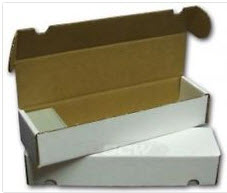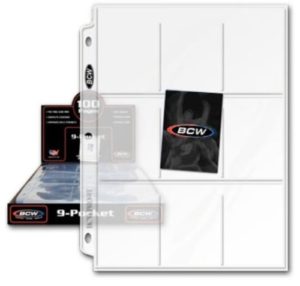Although they’re small, the amount of room our collectibles take up when the numbers start to add up is more than one would expect. Knowing the best ways to store baseball cards is the best way to keep them in good condition and an organized collection is one that’s likely to be maintained. Not to mention it is the easiest way to find the card you’re looking for.
Although many people like to use shoe boxes and they are a viable option for a run-of-the-mill collection and have been for decades, one must be careful when trying to fit cards into this particular type of box. Make sure the cards are stacked neatly and the box is filled or packed fairly tightly. If there is any extra room, the cards could potentially move around and you’ll wind up with damaged corners. It is a cheap option and is a decent choice for lower end “junk wax” or cards with extra protection.
 Since a shoe box can be a bit risky, getting 800 count storage boxes is a better bet. Big enough to store set from the 1970s on up, these offer a tight fit and will do an adequate job in card storage. If one is sorting cards alphabetically, these boxes might just be the best fit as they allow you to keep large quantities of cards stored. Easily found for under a buck, it is an unbeatable option for the price and protection they give. You can also
Since a shoe box can be a bit risky, getting 800 count storage boxes is a better bet. Big enough to store set from the 1970s on up, these offer a tight fit and will do an adequate job in card storage. If one is sorting cards alphabetically, these boxes might just be the best fit as they allow you to keep large quantities of cards stored. Easily found for under a buck, it is an unbeatable option for the price and protection they give. You can also  buy these type of boxes in smaller sizes; from 200 ct to 660 ct
buy these type of boxes in smaller sizes; from 200 ct to 660 ct. If you know how many cards are in a specific set or how many you want to pack in a box, simply buy the box that will hold that many.
You can also buy ‘monster boxes’. These hold 1600 or 3200 cards and come with a lid. They’re more for storing extra cards you might take to a show or trade night.
 If long-term storage is your goal, many collectors use D-ring binders to store their cards. This is a safe bet, but making sure the binders are in a safe place is important.
If long-term storage is your goal, many collectors use D-ring binders to store their cards. This is a safe bet, but making sure the binders are in a safe place is important.
Placing the cards in plastic sheets and then storing those pre-punched pages in binders is a very common way for collectors to store their cards.
 There are sheets big enough to store nine cards neatly per page although some people like to use both sides and get 18 cards stored per page. Either way is a viable option, although having one card in each slot is the safer bet. Sheets are available in quantity for less than 15 cents each and are a cheap way to protect your cards and still be able to page through and look at them with ease. You can store full sets or just important cards this way.
There are sheets big enough to store nine cards neatly per page although some people like to use both sides and get 18 cards stored per page. Either way is a viable option, although having one card in each slot is the safer bet. Sheets are available in quantity for less than 15 cents each and are a cheap way to protect your cards and still be able to page through and look at them with ease. You can store full sets or just important cards this way.
 As far as individual cards themselves, some people like to put their card in a penny sleeve and then put the sleeve in a toploader, although this can get pricey for those with large collections. Of course, toploaders are great for those higher-end cards and along with a penny sleeve offer the best protection for individual cards. There are thicker toploaders available for inserts and jersey cards as well as oversized items. Penny sleeves actually cost less than a penny while standard size top loaders cost around $3-4 for 25.
As far as individual cards themselves, some people like to put their card in a penny sleeve and then put the sleeve in a toploader, although this can get pricey for those with large collections. Of course, toploaders are great for those higher-end cards and along with a penny sleeve offer the best protection for individual cards. There are thicker toploaders available for inserts and jersey cards as well as oversized items. Penny sleeves actually cost less than a penny while standard size top loaders cost around $3-4 for 25.
A similar option to the toploader would be semi-rigid card savers. Thinner than toploaders, these might be a good option to protect lower end cards, as they cost just ten cents a pop for a 200 box.
Storing toploader cards can be a pain, although there is one viable option that cannot be beat. And there are monster boxes specifically made to hold toploaders with a divider in the middle so one can store up to 350 regular sized toploaders, which should be more than enough for the average collector.
Storing graded cards is never easy, but collectors are proud of the graded cards they have amassed and want to show them off. When it comes to showing off these graded cards, there are several options, including plastic boxes for PSA graded cards and other wooden boxes with locks that are best for higher valued cards you’ll want to keep for a long time.